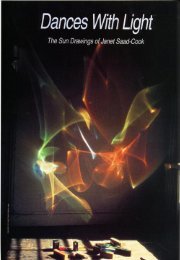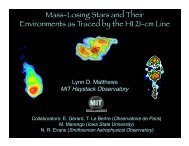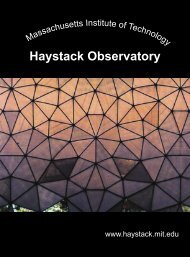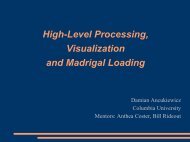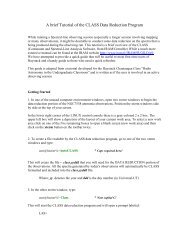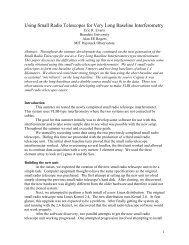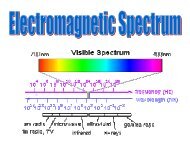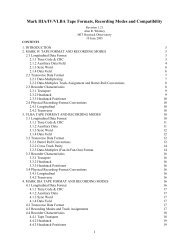059 - MIT Haystack Observatory
059 - MIT Haystack Observatory
059 - MIT Haystack Observatory
Create successful ePaper yourself
Turn your PDF publications into a flip-book with our unique Google optimized e-Paper software.
12<br />
10<br />
8<br />
6<br />
4<br />
2<br />
0<br />
0 5 10 15 20<br />
Figure 1: An example of fitting a line to data. The blue squares show simulated noisy data.<br />
The red curve is the line of best fit to these data. This line minimizes the sum of the squares of<br />
the lengths of the blue lines. For comparison, the black line shows the formula used to generate<br />
the data.<br />
is represented in Figure 1 by a vertical blue line. The best fit line (red) is close to the black line<br />
but not exactly coincident with it. In this particular example, the equation for the red line is<br />
y = 0.530x+2.956. If we had more data points, or if the errors on each data point were smaller,<br />
we would be more successful at recovering the slope and y-intercept of the black line.<br />
Effectively, this is what curve fitting is all about. When we obtain data, we may often have<br />
a good idea of the general shape of the curve that the data are trying to trace. It may be as<br />
simple as a straight line, or it may be a more complicated function. Data are inherently noisy,<br />
and therefore our estimates of the parameters of the model (in this example, the slope and<br />
y-intercept) will be imperfect. Nevertheless, the same general principle applies. The best-fit<br />
model is the one that minimizes the sum of squares of the differences between the data points<br />
and the model values. The technique of finding this model is sometimes called the method of<br />
“least squares.”<br />
3 Fitting the nighttime ozone model to MOSAIC data<br />
The script for fitting the model given in equation (1) is included in Section 4. A few explanatory<br />
comments may be helpful.<br />
The diurnal ozone signal is shown in Figure 2. Ozone is destroyed near sunrise (6 h local<br />
equinox time), and the concentration recovers near sunset (18 h ). The daytime ozone concentration<br />
appears to reach an equilibrium value shortly after sunrise, and the nighttime ozone<br />
concentration seems similarly stable starting a few hours after sunset. To avoid complications<br />
near sunrise, we will consider only the time range from 8 h to 4 h = 28 h , for which we define the<br />
variable effective time.<br />
2




